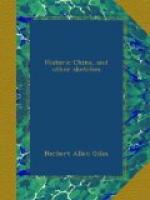That night we had visions of a large establishment in Regent Street, with an enormous placard announcing “Painless Dentistry” over the door, and crowds of dukes and duchesses mounting and descending our stairs to have their teeth extracted by some mysterious process imported from China, and known to ourselves alone. Next day we proceeded to rummage through our Chinese medical library and see what we could hunt up on the subject of dentistry. The result of this search we generously offer to our readers, thus, perhaps, sacrificing the chance of securing a colossal fortune.
In the “New Collection of Tried Prescriptions,” a sort of domestic medicine published for the use of families in cases of emergency when no physician is at hand, we find the following remarks:—
Method for Extracting Aching Teeth.
“A tooth ought not to be taken out, for by doing so the remaining teeth will be loosened. If the pain is very acute and interferes with eating or drinking, then the tooth may be extracted; otherwise, it should be left. Take a bream about ten ounces in weight, rip it open and insert 1/10 of an ounce of powdered arsenic. Then sew up the body and hang it up in the wind where it is not exposed to the sun or accessible to cats and rats. After being thus hung for seven days, a kind of hoar-frost will have formed upon the scales of the fish. Preserve this, using for each tooth about as much as covers one scale. When required, spread it on a piece of any kind of plaster, press it with the finger on to the aching place, and let it stick there. Then let the patient cough, and the tooth will fall out of itself. This prescription has been tested by Dr. Wang.”
Another Method.
“Take a head of garlic and pound it up to a pulp. Mix it up thoroughly with one or two candareens’ weight of white dragon’s bones, and apply it to the suffering part. In a little while the tooth will drop out.”
It will be noticed that the above descriptions are neither without one or other of two characteristics always to be found in the composition of Chinese remedies. In the first recipe, the ingredients are simple enough, and all this is required is time, seven days being necessary for its preparation. Now, as it is very unlikely that any one would collect the “hoar-frost” deposit from the scales of a bream stuffed with arsenic, in anticipation of a future toothache, and as he would




